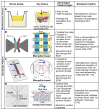Microfluidic modeling of the biophysical microenvironment in tumor cell invasion
- PMID: 28805874
- PMCID: PMC6007858
- DOI: 10.1039/c7lc00623c
Microfluidic modeling of the biophysical microenvironment in tumor cell invasion
Abstract
Tumor cell invasion, whether penetrating through the extracellular matrix (ECM) or crossing a vascular endothelium, is a critical step in the cancer metastatic cascade. Along the way from a primary tumor to a distant metastatic site, tumor cells interact actively with the microenvironment either via biomechanical (e. g. ECM stiffness) or biochemical (e.g. secreted cytokines) signals. Increasingly, it is recognized that the tumor microenvironment (TME) is a critical player in tumor cell invasion. A main challenge for the mechanistic understanding of tumor cell-TME interactions comes from the complexity of the TME, which consists of extracellular matrices, fluid flows, cytokine gradients and other cell types. It is difficult to control TME parameters in conventional in vitro experimental designs such as Boyden chambers or in vivo such as in mouse models. Microfluidics has emerged as an enabling tool for exploring the TME parameter space because of its ease of use in recreating a complex and physiologically realistic three dimensional TME with well-defined spatial and temporal control. In this perspective, we will discuss designing principles for modeling the biophysical microenvironment (biological flows and ECM) for tumor cells using microfluidic devices and the potential microfluidic technology holds in recreating a physiologically realistic tumor microenvironment. The focus will be on applications of microfluidic models in tumor cell invasion.
Conflict of interest statement
There are no conflicts to declare.
Figures



Similar articles
-
A novel method to understand tumor cell invasion: integrating extracellular matrix mimicking layers in microfluidic chips by "selective curing".Biomed Microdevices. 2017 Oct 17;19(4):92. doi: 10.1007/s10544-017-0234-8. Biomed Microdevices. 2017. PMID: 29038872 Free PMC article.
-
Microfluidics meets 3D cancer cell migration.Trends Cancer. 2022 Aug;8(8):683-697. doi: 10.1016/j.trecan.2022.03.006. Epub 2022 May 12. Trends Cancer. 2022. PMID: 35568647 Review.
-
Metastasis in context: modeling the tumor microenvironment with cancer-on-a-chip approaches.Dis Model Mech. 2018 Mar 16;11(3):dmm033100. doi: 10.1242/dmm.033100. Dis Model Mech. 2018. PMID: 29555848 Free PMC article. Review.
-
A microfluidic platform for modeling metastatic cancer cell matrix invasion.Biofabrication. 2017 Sep 1;9(4):045001. doi: 10.1088/1758-5090/aa869d. Biofabrication. 2017. PMID: 28812983 Free PMC article.
-
The matrix environmental and cell mechanical properties regulate cell migration and contribute to the invasive phenotype of cancer cells.Rep Prog Phys. 2019 Jun;82(6):064602. doi: 10.1088/1361-6633/ab1628. Epub 2019 Apr 4. Rep Prog Phys. 2019. PMID: 30947151 Review.
Cited by
-
Tumor spheroids under perfusion within a 3D microfluidic platform reveal critical roles of cell-cell adhesion in tumor invasion.Sci Rep. 2020 Jun 15;10(1):9648. doi: 10.1038/s41598-020-66528-2. Sci Rep. 2020. PMID: 32541776 Free PMC article.
-
Spheroid-on-chip microfluidic technology for the evaluation of the impact of continuous flow on metastatic potential in cancer models in vitro.Biomicrofluidics. 2021 Aug 27;15(4):044103. doi: 10.1063/5.0061373. eCollection 2021 Jul. Biomicrofluidics. 2021. PMID: 34504636 Free PMC article.
-
Unravelling Receptor and RGD Motif Dependence of Retargeted Adenoviral Vectors using Advanced Tumor Model Systems.Sci Rep. 2019 Dec 6;9(1):18568. doi: 10.1038/s41598-019-54939-9. Sci Rep. 2019. PMID: 31811202 Free PMC article.
-
Colorectal Adenocarcinoma Cell Culture in a Microfluidically Controlled Environment with a Static Molecular Gradient of Polyphenol.Molecules. 2021 May 27;26(11):3215. doi: 10.3390/molecules26113215. Molecules. 2021. PMID: 34072020 Free PMC article.
-
Vascularized microfluidic platforms to mimic the tumor microenvironment.Biotechnol Bioeng. 2018 Nov;115(11):2793-2806. doi: 10.1002/bit.26778. Epub 2018 Sep 6. Biotechnol Bioeng. 2018. PMID: 29940072 Free PMC article.
References
-
- Chambers AF, Groom AC, MacDonald IC. Nat Rev Cancer. 2002;2:563–572. - PubMed
-
- Steeg PS. Nat Med. 2006;12:895–904. - PubMed
-
- Paszek MJ, Weaver VM. J Mammary Gland Biol Neoplasia. 2004;9:325–342. - PubMed
-
- Paszek MJ, Zahir N, Johnson KR, Lakins JN, Rozenberg GI, Gefen A, Reinhart-King CA, Margulies SS, Dembo M, Boettiger D, Hammer DA, Weaver VM. Cancer cell. 2005;8:241–254. - PubMed
Publication types
MeSH terms
Grants and funding
LinkOut - more resources
Full Text Sources
Other Literature Sources

